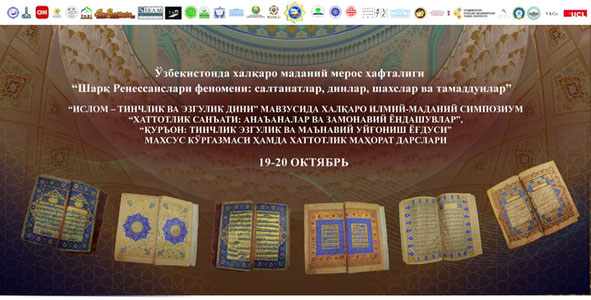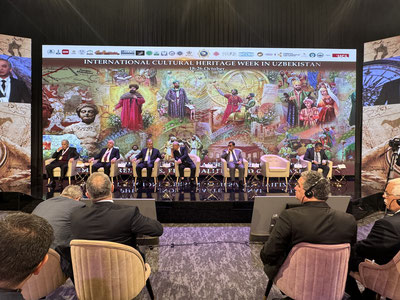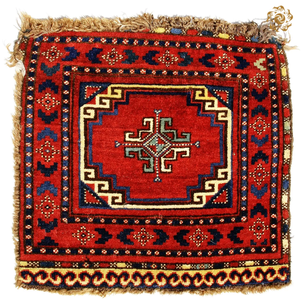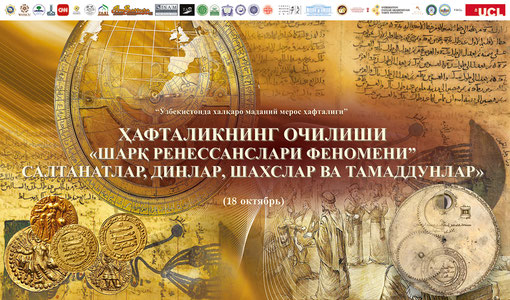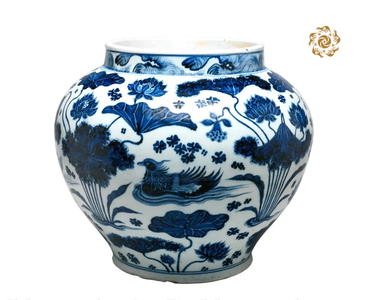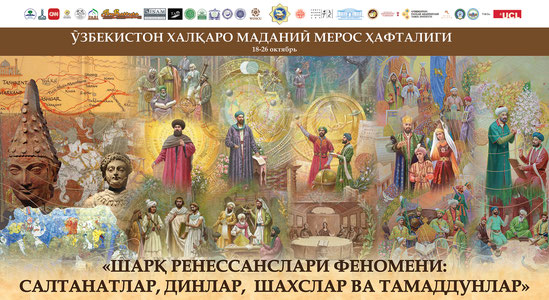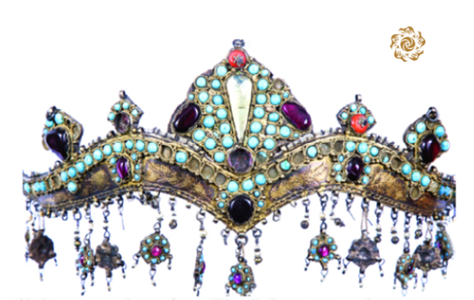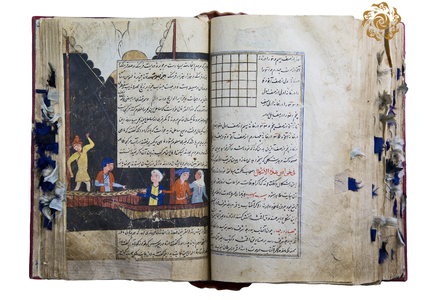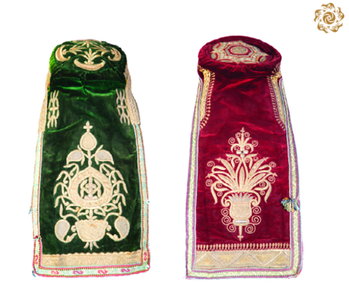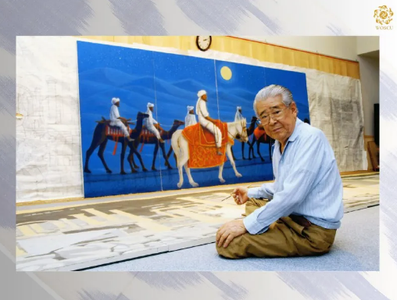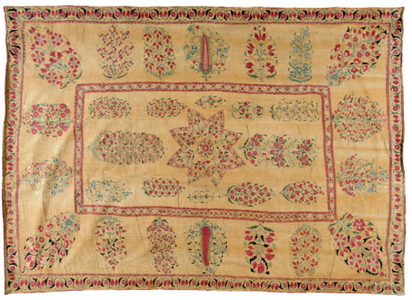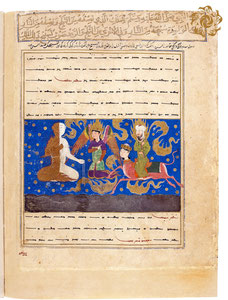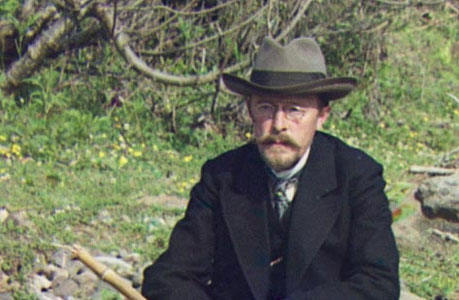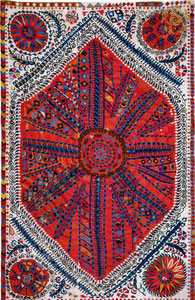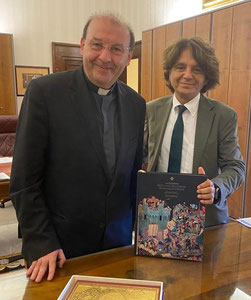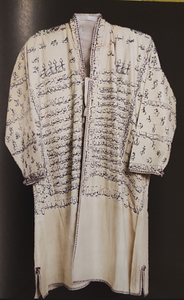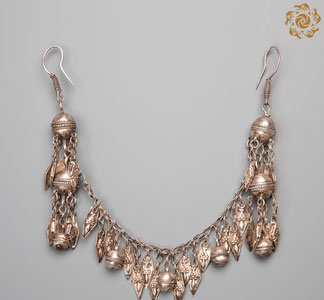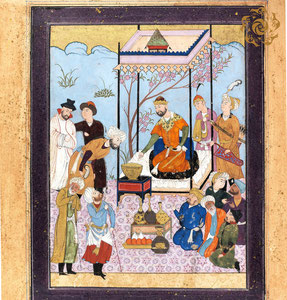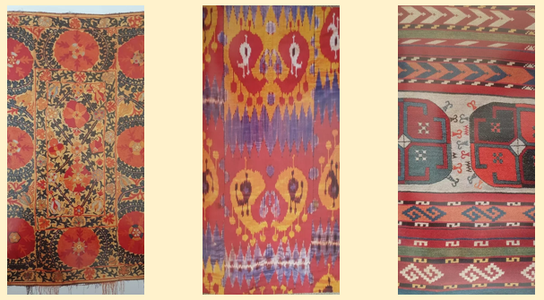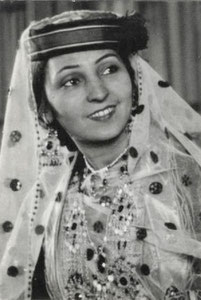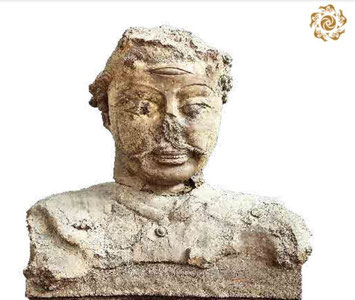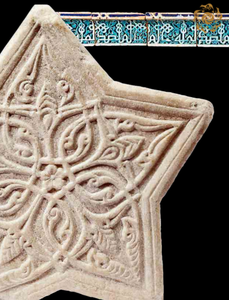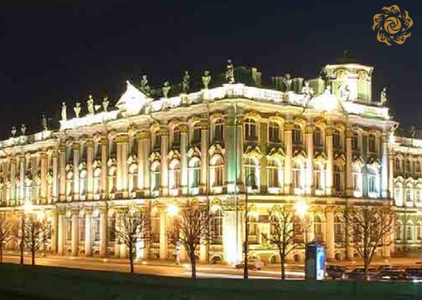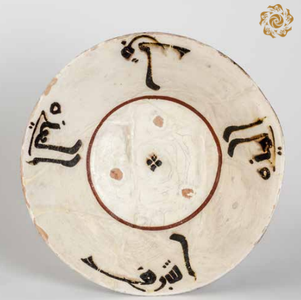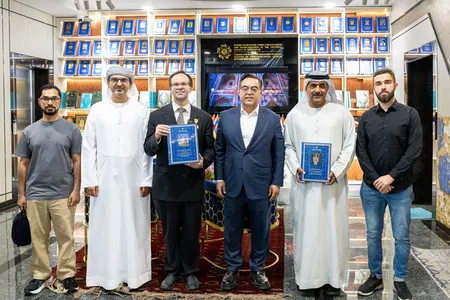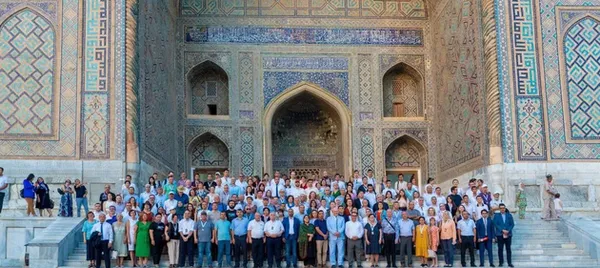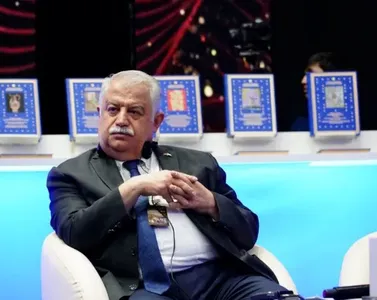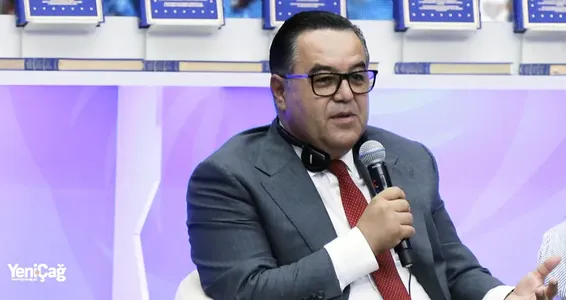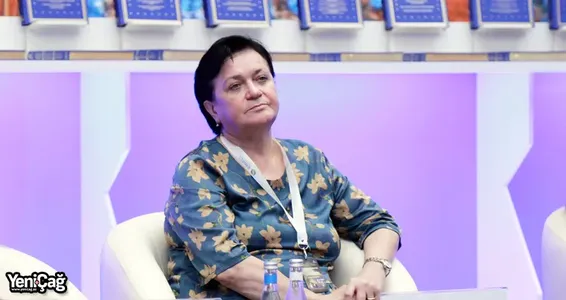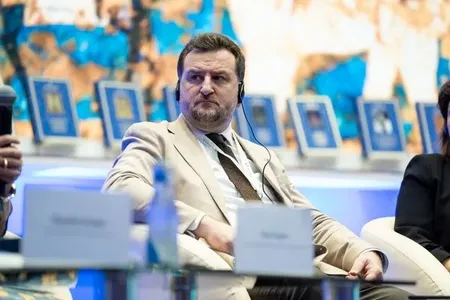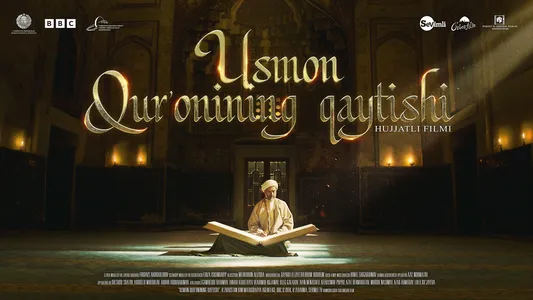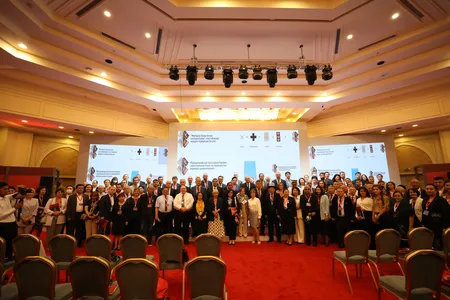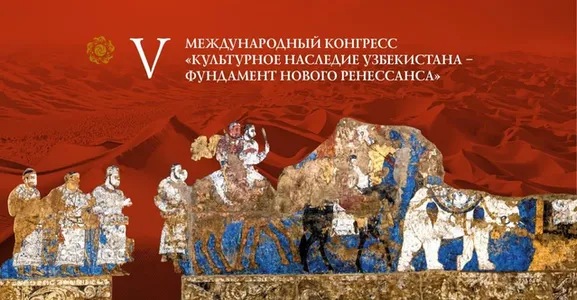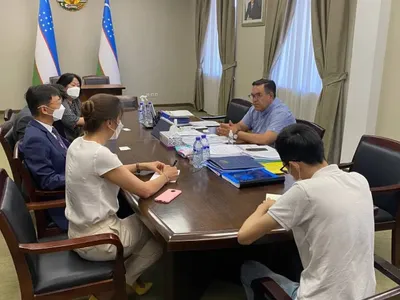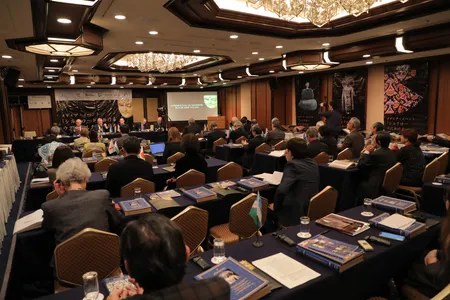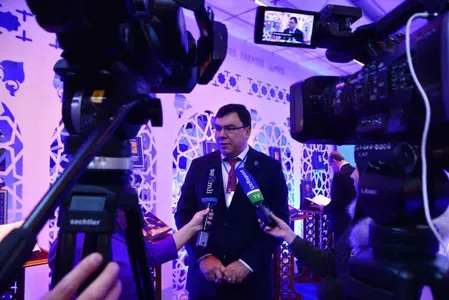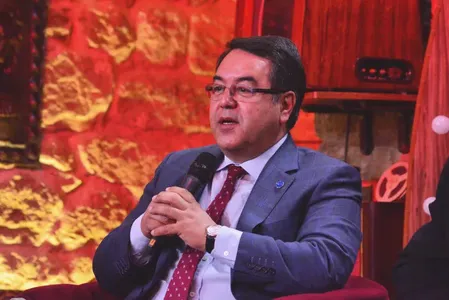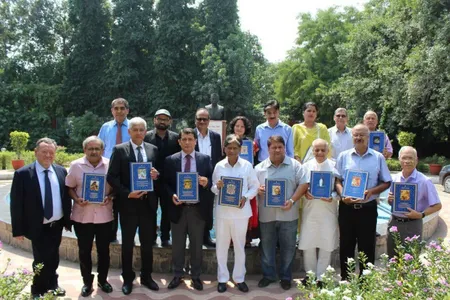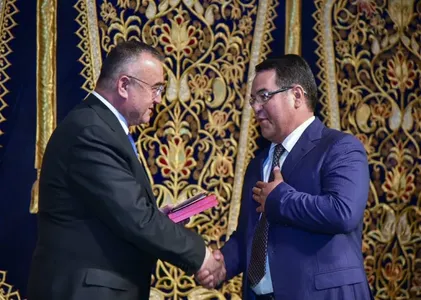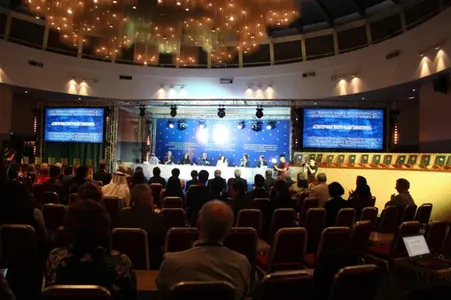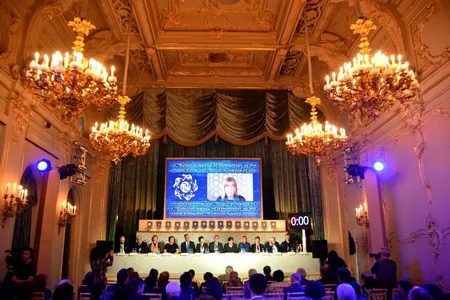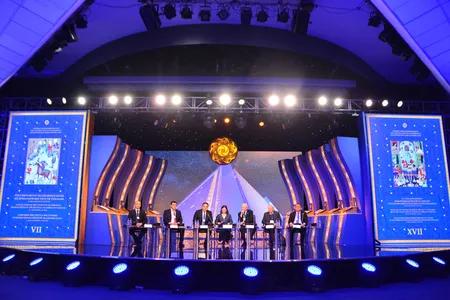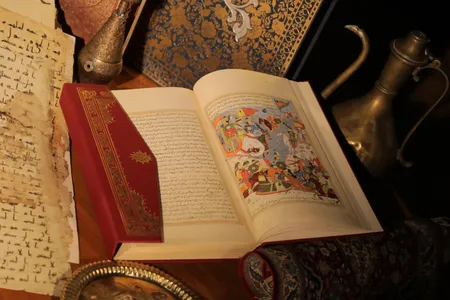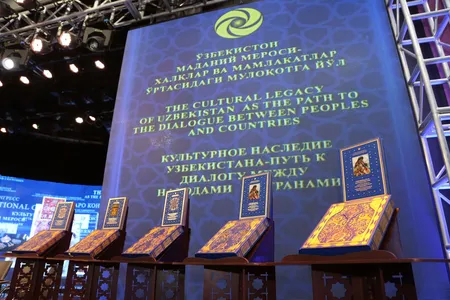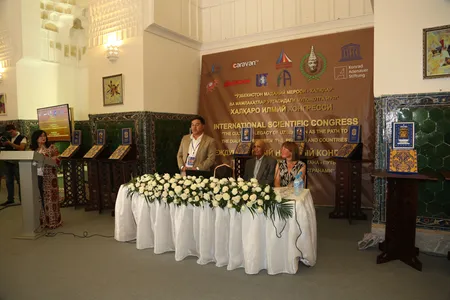The day began with the Opening Ceremony, preceded by a documentary film about the reforms in science, culture, and education being carried out in New Uzbekistan under the leadership of the President of the Republic, ShavkatMirziyoyev.
The welcoming speech was delivered by the First Deputy Chairman of the Senate of the OliyMajlis of the Republic of Uzbekistan, SodikSafoyev. Academician of the Academy of Sciences of the Republic of Uzbekistan, professor, Doctor of Law, and Chairman of the Editorial Board of the “Cultural Heritage of Uzbekistan in World Collections” project, AkmalSaidov, who acted as moderator, also emphasized the importance of the Week, during which Uzbekistan's historical heritage will be actively discussed.
The Director of the Center of Islamic Civilization in Uzbekistan, Chairman of the WOSCU Board, FirdausAbdukhalikov, spoke about the significance of international cooperation and presented the program of the Cultural Heritage Week. The film on President ShavkatMirziyoyev’s megaproject, the “Center of Islamic Civilization in Uzbekistan,” was also shown.
During the ceremony, other prominent participants responsible for various fields spoke, including Vice-President of the Academy of Sciences of Uzbekistan, BahromAbduhalimov, Academician Azamat Ziyo, and Deputy Minister of Culture of Uzbekistan, MurodjonMajidov, among others. The speakers shared information on the topics and events that will take place during the week, assuring that the upcoming activities will be a significant contribution to the development of cultural dialogue and the preservation of heritage.
After a coffee break and a press briefing, the first session of the scientific part of the Cultural Heritage Week, “The Phenomenon of the Eastern Renaissance: States, Religions, and Civilizations,” began, with renowned experts delivering speeches. The session was opened by the Deputy Director-General of the Research Center of Islamic History, Art, and Culture (IRCICA), CengizTomar (Turkey). He recalled the long-standing cooperation with Uzbekistan and confirmed the intention to implement joint projects further. In particular, he noted that IRCICA, in line with agreements with the Center of Islamic Civilization, is starting work on a project to create an encyclopedia of scholars of Uzbek lands.
Next, the President of the Institute of Manuscripts of Turkey, Joskun Yilmaz, gave his speech. He praised the progress of reforms in New Uzbekistan and discussed the need to deepen cooperation between Turkey and Uzbekistan. He especially highlighted the need to create a joint Uzbek-Turkish committee to assist scholars from both countries in implementing collaborative scientific projects. Special scientific researcher from the Miho Museum, Sergey Laptev (Japan), emphasized the importance of the Cultural Heritage Week and discussed his joint project with the Center of Islamic Civilization on the creation of a numismatic collection.
The Executive Director of the Manara Center, Bahita Ahmad Al Rumaiti (UAE), acknowledged the efforts of Uzbekistan’s leadership in preserving and promoting cultural and Islamic heritage. Islamologist, researcher at the National Center for Scientific Research of France (CNRS), and professor at the Higher School of Practical Studies, Karim Ifrak (France), reminded the audience that Uzbekistan is regaining its status as a crossroads of cultures and civilizations. He also discussed his research on locating Qurans with cultural and historical significance to Uzbekistan in world collections.
The Director of the Institute of Astronomy, Academician ShukhratEgamberdiev, also stressed the importance of the Week and the overall promotion of Uzbekistan’s cultural heritage, informing participants about the activities planned to celebrate the 630th anniversary of MirzoUlughbek’s birth. A leading specialist in Central Asian manuscripts, research fellow at the Central Asia Department of the Berlin State Library, AysimaMirsultan (Germany), spoke about new projects with the Center of Islamic Civilization.
At the conclusion of the opening ceremony, a photo session took place, followed by the signing of several memorandums of cooperation between the Center of Islamic Civilization and foreign partners.
Following the opening ceremony, a photo session took place, as well as the signing of several memorandums of cooperation between the Center of Islamic Civilization and international partners.
In the second half of the day, discussions and negotiations began, focusing on the new exhibition halls of the Museum of the Center of Islamic Civilization. The forum took place ahead of a series of project presentations aimed at enhancing the Center’s collection. Participants included staff from the Center of Islamic Civilization, overseeing the museum’s exhibitions that will be updated, as well as directors and representatives from museums across Uzbekistan.
Participants' Comments
CengizTomar – Deputy Director-General of the Research Center of Islamic History, Art, and Culture (IRCICA) "In Uzbekistan, as in Turkey, great attention is given to the study, preservation, and promotion of cultural heritage. It is encouraging that this matter is on the agenda of our countries' leaders. Both RecepTayyipErdoğan and ShavkatMirziyoyev are personally interested in the development of this field. One cannot fail to mention the success of the reforms initiated by ShavkatMirziyoyev. As for cooperation, IRCICA closely collaborates with the Center of Islamic Civilization. Recently, a delegation from Uzbekistan paid a working visit to Turkey. Preparations for the publication of an encyclopedia dedicated to Uzbek scholars are well underway."
Emmanuel Brello(France) – Lead Designer, Project Manager at Wilmotte& Associates "Uzbekistan is a country with a great history, and it is undoubtedly fascinating for us to work here. We learn something new every day. The history of this country is incredibly rich and unique. Uzbekistan has been and remains at the crossroads of civilizations and diverse cultures, distinguishing it from all the other countries we have worked in before. The architectural heritage of this country is unparalleled.
The Center of Islamic Civilization is our first major project in Uzbekistan, and we have been working on it since 2018. It is a serious challenge for us, with many tasks that need to be resolved. Our primary goal is to convey the message that the scholars and the leadership of the Republic of Uzbekistan want to communicate to the visitors of the Center."
Sergey Laptev (Japan) – Special Researcher at the Miho Museum, Doctor of Sciences "The Cultural Heritage Week is an important event held in New Uzbekistan. It is worth noting that a lot of attention has been paid to the study, preservation, and promotion of cultural heritage in the country. I would like to thank President ShavkatMirziyoyev for his efforts in studying and promoting the cultural heritage of the Republic. It must be said that the cultural heritage of Uzbekistan is a global heritage, not just the legacy of one country. We all know how scholars like Ibn Sina, Al-Khwarizmi, and Al-Biruni made significant contributions to world science. Samarkand, Bukhara, and Khiva are heritage sites of global importance. Their study is crucial for all humanity.
The Center of Islamic Civilization is not merely a museum but plays a vital role in fostering peace among nations and between religions. This is also the noble vision of President ShavkatMirziyoyev. We are happy to contribute to the cause of peace and harmony. This is an extraordinary project, unparalleled in the world. We have various ideas for creating the Center’s exhibition, which will not only serve as a platform for science and research but also for exhibitions. Specifically, I am engaged in numismatics, a field that contributes to the study of chronology and economic relations."
Bahita Ahmad Al-Rumaiti (UAE) – Executive Director of the "Manara" Center in the UAE "Uzbekistan continues to uphold the traditions passed down by its ancestors many years ago. I am impressed by how Uzbekistan's leadership pays attention to preserving cultural heritage, history, and centuries-old traditions. I am particularly impressed by the scholars' contributions to this field.
It is a great honor for me to attend Uzbekistan's Cultural Heritage Week and visit the Center of Islamic Civilization. The UAE and Uzbekistan have had deeply rooted relationships throughout history. The two countries share a common Islamic heritage, and we continue to strengthen these ties. At our 'Manara' Center, we strive to further collaborate with the Center of Islamic Civilization in Uzbekistan through the signing of a memorandum of understanding, focusing on research, cultural, and social cooperation. We visited the Center and were amazed not only by the building itself but also by the ambitions and goals set by the initiators of this megaproject. Uzbekistan has always been a cultural center and a place where Islamic philosophy has flourished."
Boris Kislitsin (Russia) – Co-founder, Creative Director of Pitch and the "Sila Sveta" Studio "The Cultural Heritage Week is undoubtedly a very important event. In terms of such large-scale events in Central Asia, I can't recall anything quite like it. Over 250 scholars have gathered, 100 of whom are from abroad. It is a remarkable event and an incredible opportunity for communication, establishing connections, and opening up the rich and fascinating history of Uzbekistan to the world, as well as sharing the prospects for its development and the ambitious plans we see being realized right now. I am very glad to be part of this process.
We have been engaged in museum and exhibition work for a long time, and it is a great honor for me to collaborate with the Center of Islamic Civilization. I want to contribute to the cause of the Third Renaissance. We are working on creating an immersive experience and the media component of the museum since it is expected that around 70% of museum visitors will be young people. We want to communicate in a language that is understandable and engaging for them. The Center of Islamic Civilization lives up to its name. There will be multilingualism, and visitors from various categories will come. We are focusing on flexible tools, such as multimedia solutions and innovative technologies, which will help create a unique, unforgettable, and seamless experience for every visitor."
HalitEren– Professor, Department of History, Namik Kemal University "Uzbekistan is an important center of Islamic culture. Under the leadership of President ShavkatMirziyoyev, impressive reforms are being carried out in the field of cultural and Islamic heritage. I am actively involved in projects at the Center of Islamic Civilization in Uzbekistan. Currently, I am working on a project regarding rare Quranic manuscripts related to Uzbekistan that are preserved in Turkey."
Karim Ifrak (France) – Professor, Quranologist, Doctor of the Sorbonne and the Higher Practical School in Paris, Chairman of the Institute of Academic Studies in Paris, Researcher at the National Center for Scientific Research (CNRS) in Paris "I would like to express my gratitude to the organizers of the Cultural Heritage Week and the country's leadership for the opportunity to participate in this event and conduct unique research.
Uzbekistan has always been and remains a crossroads of cultures. Currently, continuing research in Uzbekistan, I am convinced that Uzbek manuscripts in libraries and collections are incredibly rare. For example, the Catalan Quran and Islamic manuscripts stored in Uzbekistan’s collections inspire us to conduct further research. The more we study them, the more their rarity and uniqueness attract us, pushing us to take on new challenges."
NigoraDvurechenskaya (Russia) – Archaeologist, Candidate of Historical Sciences, Staff Member of the Department of Classical Archaeology, Institute of Archaeology of the Russian Academy of Sciences "Reforms in Uzbekistan are evident. It is clear that the New Uzbekistan has turned towards culture in many aspects. I know that Uzbek scholars have been able to breathe freely. Their lives have become easier and simpler. State funding is improving. There are now expeditions of their own. It is heartening to know that young archaeologists are entering the field. Despite the fact that it is a difficult profession, young people are eager to join, as there is now more confidence in the future."
Joskun Yilmaz (Turkey) – President of the Turkish Manuscript Association "I was very pleased to see how carefully the social complexes of great figures are preserved after visiting Samarkand and Bukhara. I am also personally acquainted with your esteemed President ShavkatMirziyoyev. We regard ShavkatMiromonovich not only as a statesman but also as a highly educated individual. That is wonderful. Overall, there is a spiritual connection between Uzbekistan and Turkey, which goes deeper than simple relations. I always emphasize to Muslims in Turkey that Uzbekistan is not just a tourist destination but a place that we all must visit, to see and understand its beauty, culture, and ancient philosophy."


